Essential Elements of Kite Repair Kits for Enthusiasts
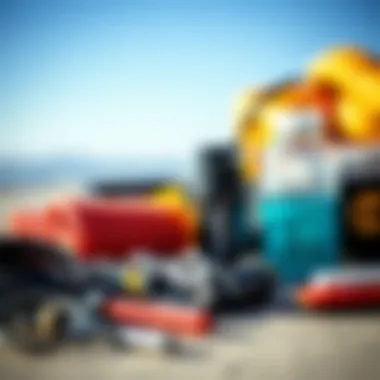
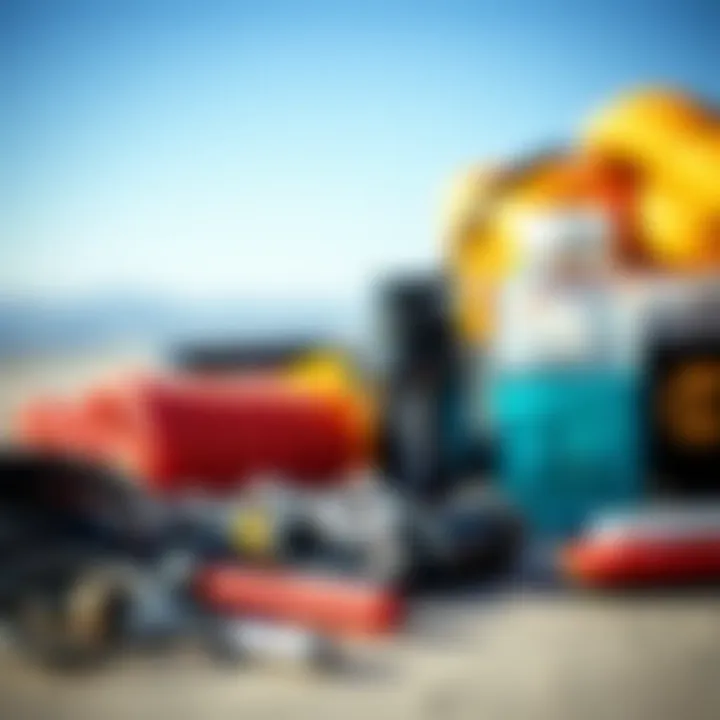
Intro
Kiteboarding, with the wind whipping through your hair and the thrill of soaring over water, can be one of the most exhilarating experiences out there. Yet, the joys of kiteboarding can quickly turn sour if your gear suffers an unexpected mishap. This is where kite repair kits come into play. They’re not just an afterthought for seasoned kiteboarders; rather, they're essential tools that can save a day on the water by ensuring your kite remains in peak condition.
Navigating the world of kite repair kits involves understanding what’s inside, why it matters, and how to correctly utilize these kits to extend the life of your equipment. After all, the last thing you want is to find yourself stranded with a damaged kite and no means to fix it.
In this guide, we will touch on the significant components found in kite repair kits, as well as practical techniques for making effective repairs. We will also dive into how to choose the right kit that aligns with your specific needs. Whether you’re a newcomer or a veteran braving the swells, knowing the ins and outs of repair kits is invaluable. So, let’s get started!
Prolusion to Kite Repair Kits
Kite repair kits are essential for enthusiasts who crave the thrill of the open sky but want to protect their investment in kiteboarding adventures. These kits go beyond mere convenience; they embody the lifesaver quality that can mean the difference between a day of soaring and a day of grounding when mishaps occur. Understanding the dynamics of kite repair kits allows kiteboarders to be proactive, enabling repairs on the fly and keeping the good times rolling.
Understanding the Importance of Repair Kits
The importance of having a kite repair kit can’t be overstated. Think of it as the toolbelt of a contractor—it holds everything needed to make fixes without having to call in a professional. This is particularly crucial for kiteboarders who often find themselves far from home or in locations where specialized services are scarce. With a well-equipped repair kit, you can quickly attend to any minor damage that may arise.
Benefits of Having Repair Kits:
- Immediate Action: Quick fixes can be executed, allowing kiteboarding sessions to continue with minimal disruption.
- Cost-Effective: Avoiding costs from professional repairs can save money in the long run.
- Skill Development: Learning to repair one’s own gear empowers riders and enhances skills in equipment management.
- Adaptability: Being prepared for unexpected damage means more freedom to explore new kiteboarding spots.
Overview of Common Kite Damage
Kiteboarding gear bears the brunt of the elements and unpredictable conditions, leading to wear and tear over time. Familiarizing yourself with common types of damage can better equip you for repair.
Some prevalent damages include:
- Tears and Rips: These can happen due to strong winds or rough handling.
- Seam Failures: Over time, seams may split, especially under high tension from gusty conditions.
- Broken Straps: Straps can wear out or break, rendering the kite unusable without repairs.
- Punctures: Sharp objects or rough surfaces can puncture the fabric, affecting aerodynamics.
Understanding these common issues enables kiteboarders to be vigilant and prepared, maintaining the performance and safety of their kites.
Having a comprehensive understanding of the common damages arms kiteboarders with awareness, fostering an attitude of vigilance and care towards their gear. The right tools and materials in a kite repair kit can save the day, transforming a potential disaster into an opportunity for adventure.
Components of a Kite Repair Kit
Repairing kites can often make the difference between a day of thrilling rides and a frustrating trip home. Having a good kite repair kit is fundamental. This section will highlight the essential components that any kite repair kit should have. Understanding these elements not only helps kiteboarders keep their equipment in tip-top shape but also ensures they are ready to tackle the surprises that can occur while out on the water. Below are some of the indispensable components that are critical for effective repairs.
Fabric Patches and Tape
Fabric patches and tape form the backbone of any kite repair kit. These elements are particularly important because they provide quick solutions for small holes and tears that can develop during usage. Kite fabric can be as light as a feather yet as strong as steel, so choosing the right material for patches is crucial. Many opt for ripstop nylon, which not only prevents further tearing but also resists harsh weather conditions.
- Types of Patches:
- Self-adhesive patches: Easiest to use and great for quick fixes.
- Sew-on patches: Offer long-lasting durability, though they require more effort.
Utilizing high-quality tape can also prevent the damage from worsening. Look for tape that is strong and weather-resistant, ensuring it will last against wind and water.
Adhesives and Glue
You might say that adhesives are the unsung heroes of kite repair kits. A good adhesive can bond the fabric back together seamlessly, restoring the integrity of your kite. It's essential to choose a glue that is specifically formulated for kite materials; some glues are designed to work with both fabric and plastic, if you're dealing with structural elements like struts or rings.


- Popular Options:
- Silicone-based adhesives: Provide flexibility and waterproofing, suitable for a variety of materials.
- Epoxy: Offers a robust bond, but can be less flexible once cured.
Always read the instructions carefully. The last thing you want is a failed repair because of improper application.
Tools for Repair
While it might be tempting to think you can get by without tools, having the right ones can simplify your repair process immensely. A few handy tools can make a world of difference.
- Essential Tools:
- A small pair of scissors or a utility knife for cutting patches.
- A needle and thread for sewing seams back together.
- A roller or burnishing tool to smooth down patches and ensure good adhesion.
If you're serious about kiteboarding, consider investing in quality tools as they can offer you not only efficacy in repairs but also a sense of confidence knowing you've covered all bases.
Sealing Products and Accessories
After you've repaired a tear or glued a seam, sealing products act as the cherry on top, ensuring that your fixes are watertight and air-tight. They can extend the life of your repairs.
- Sealants:
- Liquid sealants: They can be applied over patches for extra security, particularly in high-stress areas.
- Fabric sealant spray: An excellent choice for additional water resistance.
Accessories like zip ties and small replacement parts (like clips or stoppers) can also be incredibly handy. They can help you deal with unexpected challenges without having to return home early.
In summary, having a thoughtful selection of components in your kite repair kit can mean the difference between a day full of adventure and one filled with disappointment. Always aim for quality over quantity when putting together your kit. These elements serve not just as fixes but as peace of mind.
Selecting the Right Kite Repair Kit
Choosing the right kite repair kit goes beyond simply picking one off the shelf. It's about finding a kit that aligns with your specific needs as a kiteboarder and empowers you to tackle repairs efficiently. The right kit not only helps maintain your kite's functionality but can also extend its lifespan. When making this crucial decision, certain factors come into play that can affect your kiteboarding experience.
Factors to Consider
Before settling on a kite repair kit, it’s wise to consider a few essential aspects that can make a world of difference in how well you can address damages on your gear.
Type of Kite
When discussing the type of kite, it's crucial to consider the design and materials used. Different kites, such as inflatable, foil, or hybrid kites, require specific repair strategies and materials. For instance, inflatable kites typically feature air bladders and durable fabric that can be easily patched with specific types of fabric tape, whereas foil kites might need more specialized attention due to their internal structures.
A key characteristic of inflatable kites is their ability to absorb impact, making them popular for beginners, yet they can also be prone to punctures. This makes having a robust repair kit with patches designed for PVC or TPU materials extremely beneficial. On the other hand, foil kites usually present a unique challenge as they are often more lightweight and might need a different adhesive or fabric to ensure a proper seal.
Riding Style
Your riding style significantly influences the kind of repairs you'll likely face. Different styles, like freestyle or wave riding, produce unique stresses on kites. Freestyle riders, who often engage in tricks and jumps, might see more wear and tear in their kites due to heavy impacts and abrasion. Thus, having a repair kit with robust fabric patches and flexible adhesives could be advantageous.
In contrast, wave riders often face the challenge of saltwater exposure and wind, potentially causing fading or tearing. Opting for a kit that includes UV-resistant materials could help in this scenario, thus making it a wise choice for those who prefer riding in ocean conditions.
Frequency of Use
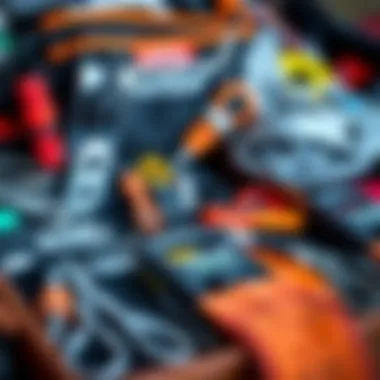
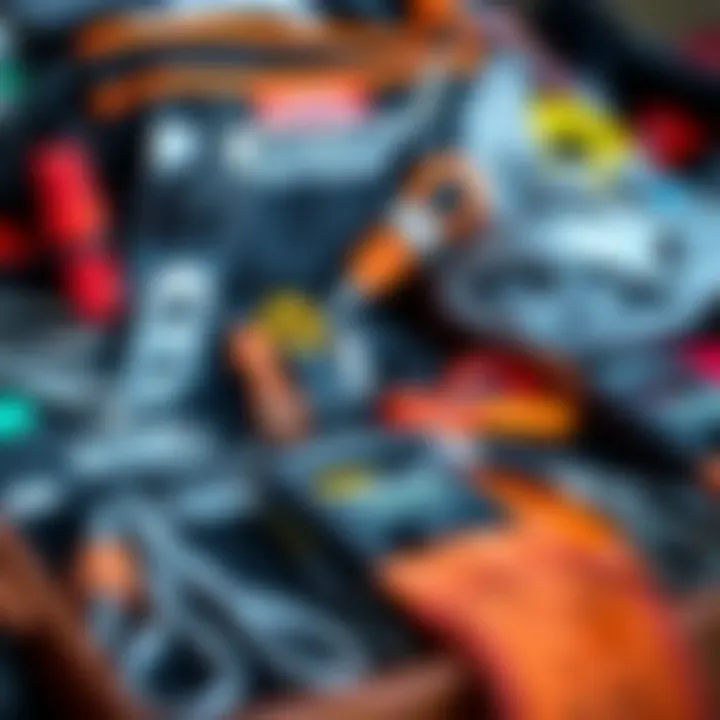
The frequency with which you use your kite should also factor into your choice of repair kit. If you hit the water every weekend, purchasing a comprehensive kit tailored to frequent use might be the smartest path. Frequent usage typically leads to quicker wear and increases the likelihood of encountering problems.
Notably, having readily available supplies like double-sided adhesive tape and various fabric patches can save you time and frustration before heading out to ride. However, for casual riders who kite just a few times a year, a more basic repair kit with essential components may be sufficient and cost-effective.
Brands and Recommendations
Selecting a kite repair kit isn’t just about the contents; it’s also about the brand reputation. Some brands, like North Kiteboarding and Gusty Kites, offer reliable kits designed specifically for different kite types. Always check user reviews and community forums like Reddit or Facebook groups where kiteboarders share their thoughts and experiences on various brands. A little bit of research can save you from a lot of trouble down the line.
Common Repair Techniques
Repairing a kite is not just about fixing it; it also preserves the thrill that comes with the sport. Whether you're cruising over waves or soaring high in the sky, having the skills to implement common repair techniques can make all the difference in your kiteboarding experience. In this section, we will delve into some essential techniques that can help you maintain your kite's integrity and extend its life.
Patching Holes
Holes in the kite fabric are likely to occur, especially during those windy days. To patch a hole effectively, first, assess the size and location of the damage. Select a fabric patch that matches your kite's material. Clean the area around the hole to ensure proper adhesion. This makes a world of difference. For example, if you're dealing with a small puncture, a simple adhesive patch can do the trick. Make sure it overlaps the hole by at least half an inch.
Next, apply pressure to the patch for a few minutes and allow it to set. Use a roller if you have one, as it evenly distributes the pressure. This process not only fixes the hole but also reinforces the fabric's strength.
Repairing Seams
Seams are the backbone of a kite's structure, holding various parts together. If a seam begins to come apart, it can significantly affect performance. Depending on the level of damage, you can either sew the seam or use specialized seam tape.
- Sewing a seam: If you opt to sew, make sure to use a heavy-duty thread that matches your kite’s color. A zigzag stitch can offer extra security. Don’t skimp on this step; a well-sewn seam can help prevent further issues down the line.
- Using seam tape: Alternatively, if you lack sewing skills, applying seam tape can work wonders. Similar to fabric patches, make sure the area is clean before applying the tape. Roll it out evenly, ensuring no air bubbles or creases exist.
Fixing Rips and Tears
Rips and tears may occur from wear and tear or sudden mishaps. It's advisable to handle these promptly, as left unchecked, they can lead to larger issues. For small rips, fabric tape can be your best friend. Cut a piece of tape that is a bit larger than the tear and apply it as one would with a hole. For larger tears, you might need to reinforce both sides with patches.
Before applying any adhesive, you might want to sew the edges of the tear together if they are ragged. This acts as a tidy barrier, preventing the fabric from fraying further. Once the tear is sewn, use fabric patches to cover and secure the area thoroughly.
Replacing Broken Straps and Components
Kites rely on various straps and components to function properly, including the lines, bridles, and even the leading edges. If you find any of these parts are broken, replacing them is crucial. Start by identifying the damaged component - is it a strap, or perhaps a line?
- For broken lines: Make sure to use high-quality replacement lines that are compatible with your kite model. Measure the broken line before cutting the new one to the correct length. Once you have the right size, thread the new line through the same points as the old one and ensure it's secured correctly.
- For straps: Examine where the strap meets the kite and then remove it. Attach a new strap by threading it through the same loops and securing it tightly. Use durable stitching if necessary, as this adds an extra layer of reliability.
"A stitch in time saves nine"; staying ahead of small repairs can save you from greater headaches later.
Maintaining your kite by knowing these common repair techniques ensures you can have uninterrupted fun in the sun. Remember to practice these methods regularly, as familiarity will only enhance your confidence when damages arise.
Maintenance Tips for Longevity
Maintaining your kite isn't just about waiting for something to break before you take action. The longevity of your gear rests heavily on regular care and attention throughout its life. Proper maintenance pays off in spades, prolonging your kite's performance and ensuring safety on those windy days. By applying the right techniques, not only can you prevent damage, but you can also optimize your overall kiteboarding experience.
Storing Your Kite Properly
The way you store your kite can make all the difference in the world. Leaving it bunched up in a corner or, worse yet, stuffed into a tight bag can quickly lead to creases and deformities. Here's what to keep in mind:
- Dry It Out: Always dry your kite completely before storage. Any dampness can lead to mold and mildew, which can rot fabric over time.
- Loosely Fold It: Instead of cramming it into the bag, folding your kite loosely will help maintain its shape. When it's time to use it again, this can make all the difference in flight stability.
- Choose the Right Environment: Store your kite in a cool, dry place, away from direct sunlight. UV rays can degrade the fabric, making it more prone to wear and tear.
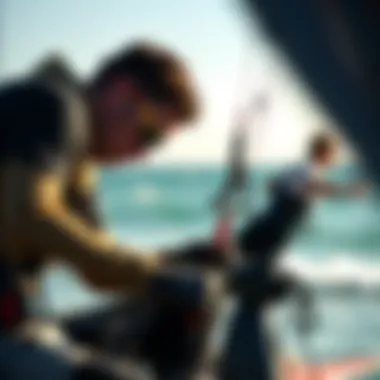
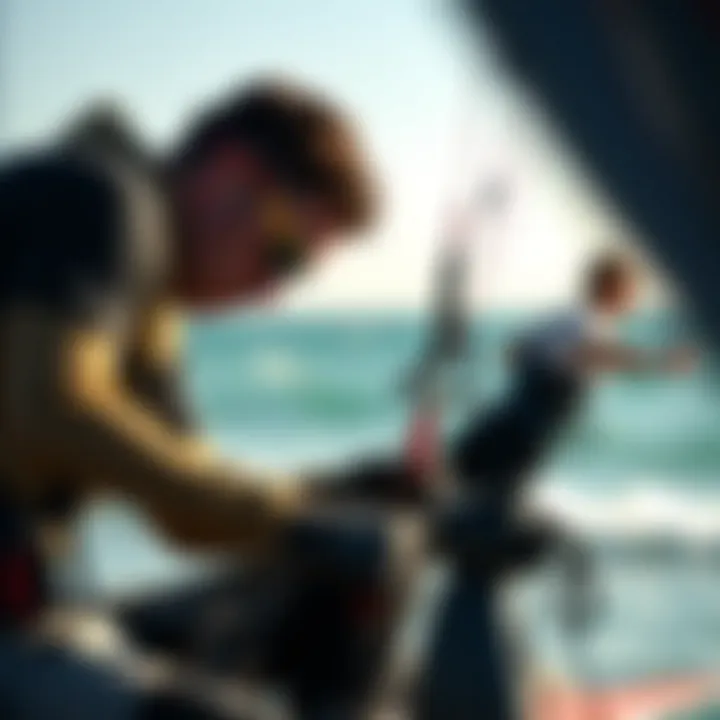
By following these simple steps, you ensure your kite stays in tip-top shape, ready for your next adventure.
Routine Inspections
Being proactive in inspecting your kite regularly is not just a good habit; it’s essential. Just as you wouldn’t ignore warning lights in your car, you shouldn’t overlook signs of wear and tear in your kite. Here are key aspects to focus on:
- Check for Tears: Look for any rips or punctures that could worsen if left untreated. A small hole can quickly expand in high winds.
- Inspect the Straps and Components: Make sure that all straps are secure and not frayed, as these are critical for your safety.
- Look for Discoloration: Changes in fabric color can indicate UV damage or wear, which means it might be time for a patch or a replacement.
Regularly inspecting your kite not only extends its life but also gives you peace of mind when you're out on the water.
Cleaning Techniques
Cleaning your kite may not be the first thing on your mind after a day of kiteboarding, but it should be part and parcel of your maintenance routine. Sand, saltwater, and other debris can accumulate, leading to long-term damage. Follow these basic steps to keep your kite clean:
- Rinse It Off: After a session, give your kite a thorough rinse with fresh water. This helps eliminate salt and sand that might cause fabric damage.
- Use Mild Soap: For deeper cleaning, consider using a mild soap solution. Avoid harsh chemicals that might irritate the fabric or compromise its integrity.
- Inspect After Cleaning: While washing, take the time to inspect for any new wear or tear, making future repairs easier.
"A little cleanliness goes a long way! Keeping your kite clean ensures that it not only looks good but performs well too."
Following these maintenance tips can turn an average kite session into a stellar one, prolonging the equipment you love and enhancing your overall riding experience.
The Role of Professional Repair Services
When it comes to keeping your kite in top shape, professional repair services can play a pivotal role. While many kiteboarders embrace the DIY spirit, there are times when the expertise of a professional becomes invaluable. Knowing when to turn to these experts can save your kite—and your day on the water—in the long run.
When to Seek Professional Help
In certain situations, seeking professional help is no longer a debate but a necessity. Here are some scenarios that warrant reaching out:
- Significant Damage: If your kite has a sizable tear, a large hole, or multiple damaged areas, professional repair may be your best option. Complex repairs demand specific knowledge and tools that only experts can provide.
- Structural Integrity: When the integrity of your kite's frame is compromised, it's vital to consult with a professional. They can assess whether repairs are feasible or if a replacement is more prudent.
- Material Specifics: Different kites use various materials, and repair methods can vary considerably. Professionals are usually well-versed in these specifics and can ensure that the correct materials and techniques are used.
- Time Constraints: If you have an upcoming trip and don't have the time or skills to make effective repairs, professional services can expedite the process and have your kite ready in no time.
Understanding Repair Costs
Understanding the financial side of kite repairs is essential for kiteboarders making informed decisions about their gear. Here’s a breakdown of what to expect:
- Cost Factors: Repair costs can vary based on the extent of the damage, the materials needed, and the labor involved. For example, simple patching might cost less than structural repairs needing replacement parts.
- Average Prices: Many kite repair shops charge based on the complexity of the repair. On average, you may see costs ranging from $20 for basic patch work to upwards of $100 for more involved repairs.
- Timeframe for Repairs: Quick turnaround may come at a premium, so understanding the timeline is crucial. You could pay more for expedited service if you’re in a rush.
- DIY vs. Professional Costs: While some repairs can be tackled at home with a kite repair kit, weighing the costs versus potential consequences of a botched job is wise. For example: A minor DIY patch might save cash, but if it fails, you could be looking at a larger expense for professional help afterward.
“Investing in professional repairs can safeguard your kite’s longevity and performance, so don’t underestimate their value.”
Epilogue
In this article, we’ve highlighted the crucial role that kite repair kits play in prolonging the life of your kiteboarding gear. Understanding the components within these kits, combined with practical repair techniques, allows kiteboarders to tackle common issues and avoid costly replacements. The ability to perform simple repairs not only enhances your experience on the water but also instills a sense of confidence in handling any unforeseen circumstances.
Summarizing Key Points
To encapsulate, here are the main takeaways from our guide:
- Importance of Repair Kits: Kite repair kits are essential in maintaining the integrity of kites, especially considering the rigors they endure in harsh conditions.
- Key Components: Understanding what’s inside a repair kit—fabric patches, adhesives, and tools—equips you with knowledge on how to tackle repairs effectively.
- Common Techniques: Mastering patching holes and fixing seams can save you time and expense, ensuring you’re ready to ride when conditions are favorable.
- Maintenance Matters: Regular checks and proper storage can prevent damage before it happens, giving your kite a longer lifespan.
Encouraging Preventative Measures
Preventative strategies can make all the difference in kite care. Here’s what to keep in mind:
- Regular Inspections: Make it a habit to check for any signs of wear and tear. A small tear today can become a big headache tomorrow. Diligence is key.
- Clean After Use: Saltwater and sand can do a number on your kite. A simple rinse can help avoid unwanted damage. Always store your kit properly after cleaning to protect its contents.
- Stay Educated: Continuous learning about repair techniques and materials can keep you ahead of issues that might arise. Joining a community on platforms like Reddit or following kiteboarding pages on Facebook can provide valuable insights.
Ultimately, being proactive with kite care not only saves money but also enriches your kiteboarding adventure. With the right repair kit at hand and a bit of know-how, you'll be set to ensure that those winds stay at your back and your kite remains in top shape.















